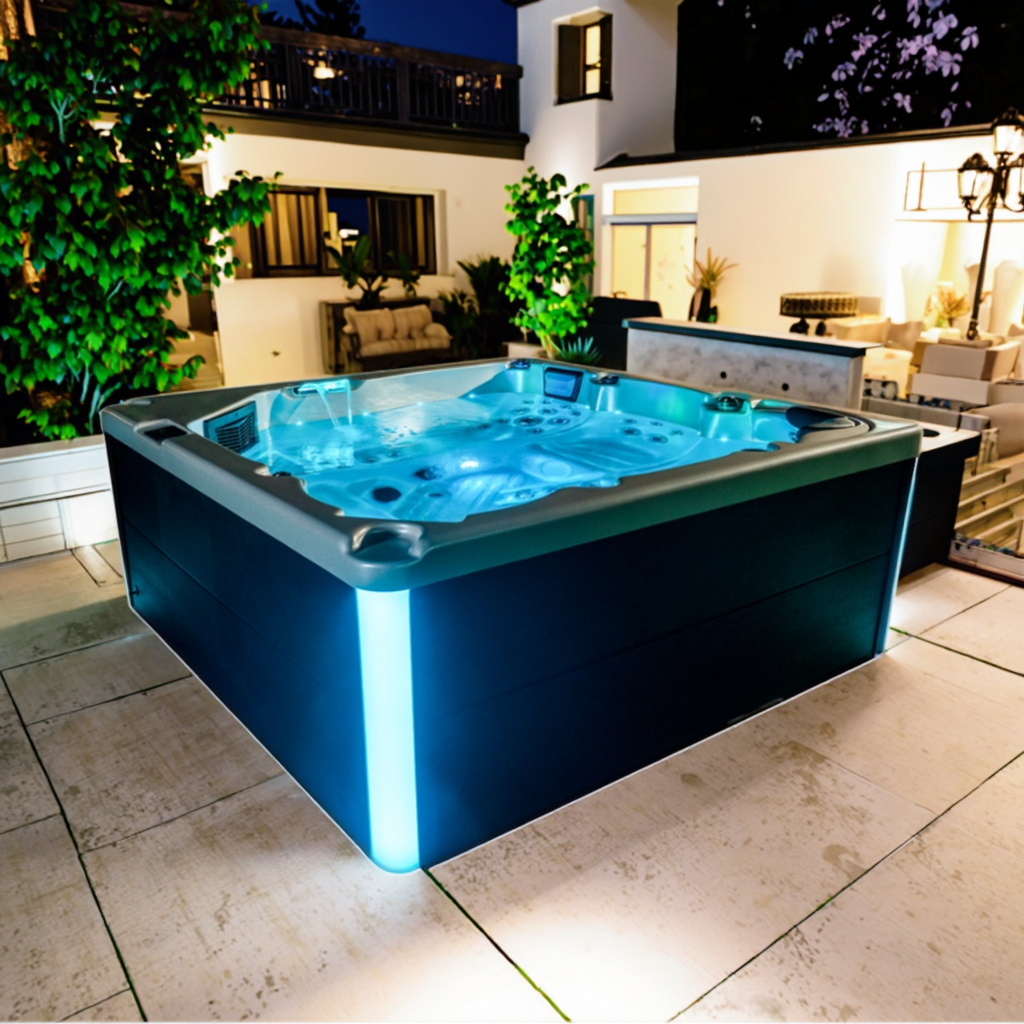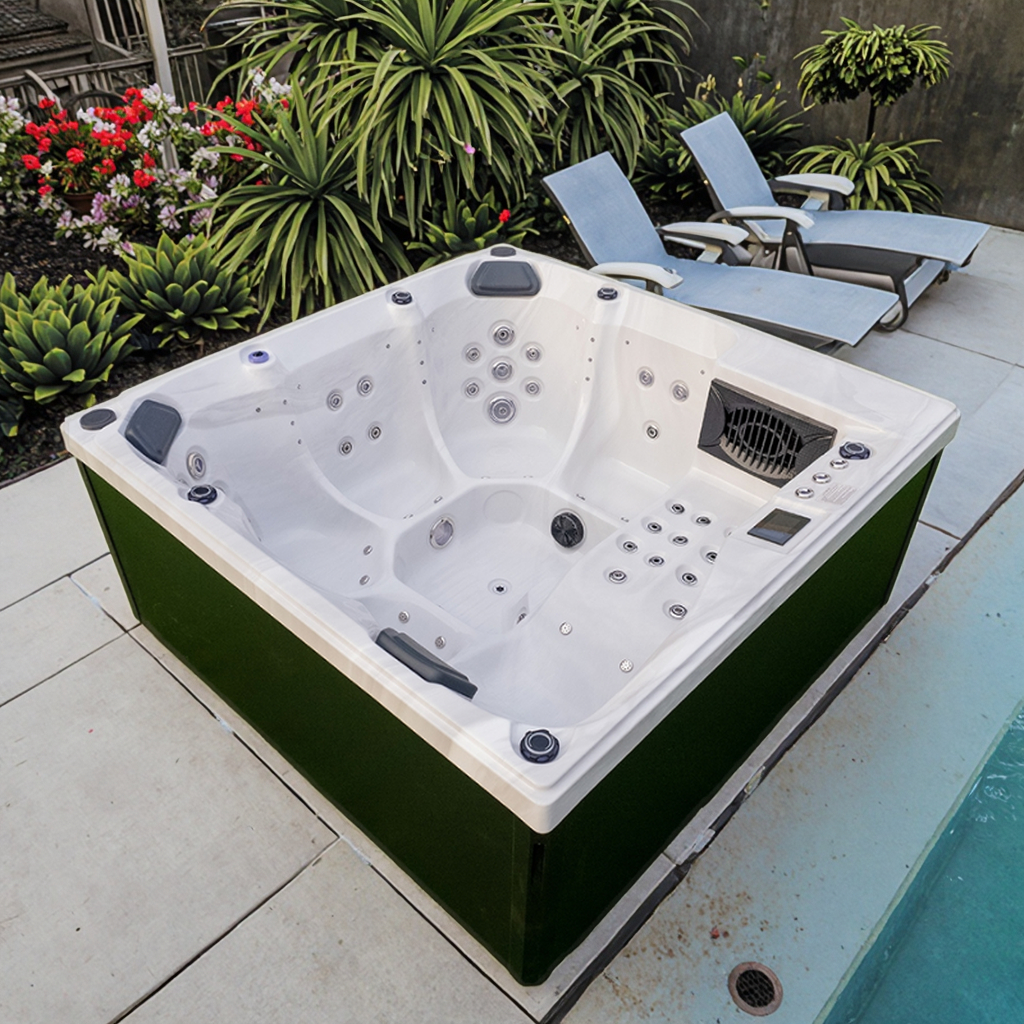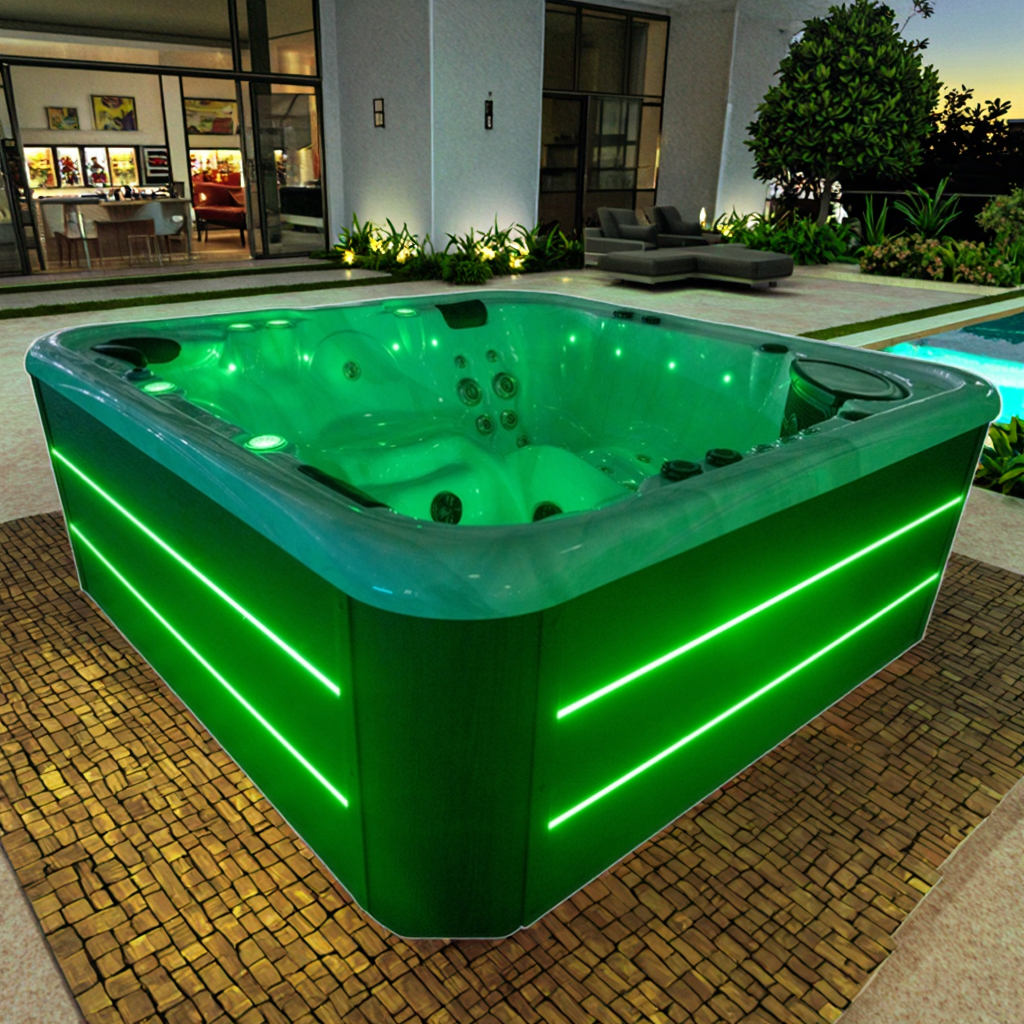
How to remove mold from a Freestanding spa jacuzzi tub?
2025-11-27 15:30Many users find that no matter how much they clean it, black spots or a slimy film always seem to appear in the nozzle crevices, inside the pipes, or at the silicone seams of the Freestanding spa jacuzzi tub. This is a typical sign of mold and biofilm growth.

Why does a Freestanding spa jacuzzi tub easily breed mold?
1. A damp, warm environment is a breeding ground for mold
Mold growth requires very simple conditions: moisture + temperature + organic nutrients.
The Freestanding spa jacuzzi tub provides all of these:
• A warm water environment (30℃~40℃) is suitable for mold reproduction;
• Prolonged humidity allows mold to continue growing;
• Shower gel, dead skin cells, and grease residue provide nutrients.
Therefore, even a seemingly clean Freestanding spa jacuzzi tub can harbor mold if the inside is not completely dry.
2. Residual Water in the Piping System is Difficult to Drain Completely
Unlike a regular bathtub, a freestanding spa jacuzzi tub has a complex piping structure.
Each nozzle is connected to an internal circulation system, meaning some water remains in the pipes after the massage.
These stagnant water spots provide a "hidden habitat" for mold, allowing it to thrive even when the exterior appears clean.
3. Insufficient Cleaning Frequency or Improper Methods
Many freestanding spa jacuzzi tub users believe that simply draining the water and wiping the surface is sufficient for cleaning. However, mold is most likely to hide inside the unseen pipes.
Without regular deep cleaning and disinfection, mold will repeatedly grow.

How to Determine if Mold Has Appeared in Your Freestanding Spa Jacuzzi Tub?
To remove mold, you first need to know how to determine its presence. The following signs usually indicate that your freestanding spa jacuzzi tub is contaminated with mold.
1. Black or Brown Debris from the Outlet
If black, gray, or brown granular material sprays from the nozzle when you restart the massage system, this is often a sign of mold sloughing off from the pipes.
These debris are actually a mixture of mold and biofilm.
2. Unpleasant Odor or Musty Smell
Mold releases metabolic gases during its growth, such as musty, sour, or damp wood smells.
If your Freestanding Spa Jacuzzi Tub still emits this odor when not in use, it means that mold has been growing inside for some time.
3. Black Spots in the Nozzles and Silicone Seams
Observe the bathtub rim, the bottom of the nozzles, or around the drain hole for black, dark green, or brown spots.
These are usually visible areas where mold has adhered to the surface.
What are the best steps to remove mold from a Freestanding Spa Jacuzzi Tub?
The key to thoroughly removing mold is to clean both the external and internal circulation systems simultaneously. Below are the scientific and safe steps.
1. Step 1: Drain and Clean the Surface
First, completely drain the water from the freestanding spa jacuzzi tub.
Use a soft sponge and a neutral detergent (avoid chlorine bleach) to wipe the tub surface to remove grease and soap residue.
After cleaning the surface, rinse thoroughly with clean water to prevent detergent residue.
2. Step 2: Refill with Warm Water and Circulate
Refill with warm water (approximately 40°C), ensuring the water level is 2-3 cm above all nozzles.
Add the following to the water:
• Professional bathtub drain cleaner (or a mixture of white vinegar and baking soda);
• Add as directed and stir well.
Turn on all nozzles and the circulation pump, allowing the system to run for 15-20 minutes.
This process will thoroughly flush out mold, slime, and impurities adhering to the pipes.
3. Step 3: Settle and Recirculate
After circulation, let it sit for 10 minutes, then restart the system for 5 minutes.
At this point, any remaining mold will be completely dissolved and expelled. Then drain the water and refill with clean water, circulating for 10 minutes to rinse away any remaining cleaning agent.
4. Step Four: Focus on Cleaning the Nozzles and Sealing Edges
Use an old toothbrush or soft-bristled brush dipped in white vinegar to clean the nozzle crevices, drain outlet, and silicone seams.
These areas are most prone to harboring bacteria. After cleaning, dry with a towel and ensure ventilation.
5. Step Five: Complete Drying
After completely draining all water from the freestanding spa jacuzzi tub, open the lid or window to allow the tub to air dry naturally.
If the ambient humidity is high, use a dry towel to absorb the moisture or briefly turn on the heater to assist drying.

What cleaning agents can be used to remove mold?
The choice of cleaning agent is crucial because the internal pipes of the freestanding spa jacuzzi tub are mostly made of plastic, rubber, or stainless steel. Using strong corrosive cleaning agents will damage the materials.
1. White Vinegar
The weak acidity of white vinegar can effectively break down mold cell walls and remove limescale.
• Dosage Ratio: Mix white vinegar and water in a 1:1 ratio.
• Advantages: Safe, environmentally friendly, and residue-free.
• Disadvantages: Slower action on stubborn mold; requires hot water.
2. Baking Soda
Baking soda is slightly alkaline and reacts with white vinegar to form bubbles, helping to loosen attached substances.
Suitable for hard-to-clean areas such as nozzles and drains.
3. Professional Drain Cleaner (Chlorine-Free Formula)
There are commercially available drain cleaners specifically designed for freestanding spa jacuzzi tubs. These typically contain enzymes or oxygen-based active ingredients that quickly dissolve biofilm.
Recommended for monthly use; noticeable results and safety.
What are some common mistakes when removing mold?
Even with cleaning awareness, many users still make common mistakes during operation, which not only result in poor cleaning but may also damage the equipment.
1. Using bleach or strong acid cleaners
While bleach can kill bacteria, its strong oxidizing properties will corrode the rubber seals of the Freestanding Spa Jacuzzi tub pipes and nozzles. Long-term use can also cause plastic parts to become brittle and discolored.
2. Neglecting circulation cleaning
Cleaning only the surface without cleaning the circulation system is like treating the symptoms, not the root cause. Mold will still regrow from inside the pipes, returning to its original state within a few days.
3. Not thoroughly drying after cleaning
Residual moisture will allow mold to grow back quickly. After cleaning, be sure to completely drain the water and ensure proper ventilation and drying.
How often should you clean your Freestanding Spa Jacuzzi tub?
The cleaning frequency depends on usage frequency and water quality, but the following is generally recommended:
Usage Frequency | Recommended cleaning schedule |
| Daily Use | Deep clean every two weeks |
| 2-3 Times Per Week | Deep clean once a month |
| Occasional Use | Clean every two months |
| Long-Term Inactivity | Wash thoroughly before and after use |
Additionally, it is recommended to run the circulation system with clean water for 5 minutes weekly to keep the internal pipes clean.
How to prevent mold regrowth after removal?
Removing mold is only the first step; preventing recurrence is key to maintaining hygiene.
The following are professional mold prevention and maintenance recommendations.
1. Drain and Ventilate Immediately After Each Use
Drain the water immediately after use and open the cover or window to ventilate, allowing the inside of the freestanding spa jacuzzi tub to dry completely.
Maintaining air circulation is the primary condition for preventing mold growth.
2. Run a Clean Water Circulation System Regularly
Even if you don't use the freestanding spa jacuzzi tub frequently, it is recommended to fill it with clean water and run the system for a few minutes weekly to refresh the residual water and prevent sediment buildup.
3. Maintain Suitable Water Quality
If your area has hard water and is prone to limescale buildup, use a descaling agent regularly.
Limescale is the "attachment substrate" for mold; reducing limescale reduces the foundation for mold growth.
4. Use an Anti-Mold Cover
When the freestanding spa jacuzzi tub is not used for an extended period, cover it with a breathable anti-mold cover to effectively prevent dust and moisture buildup.

Why Does the Structural Characteristics of the Freestanding Spa Jacuzzi Tub Make Mold Recurrence Prone?
Understanding the structure helps explain why mold is prone to recurrence.
1. Multiple Nozzle System Leads to Numerous Water Flow Branches
Each nozzle is connected to an independent pipe branch, meaning numerous small spaces exist.
If these spaces are not thoroughly cleaned, residual water remains, providing a breeding ground for mold.
2. Closed-Loop Internal Circulation but Not Completely Drained Design
The Freestanding Spa Jacuzzi Tub's circulation system is a closed-loop structure, but it is not a completely drained design.
After shutdown, a small amount of water always remains in the bends and pump body cavity.
3. Accumulation of Organic Contaminants
Dander, essential oils, and shower gel ingredients adhere to the pipe walls, forming a "biofilm."
Mold attaches to and multiplies on this biofilm, leaving a nutrient source even after drainage.
Why is it important to remove mold from Freestanding Spa Jacuzzi Tubs?
Some people think mold is just "dirty," but it actually poses potential health hazards.
Mold releases spores into the air and water, potentially causing:
• Respiratory irritation or allergies;
• Skin itching and rashes;
• Abnormal immune responses in infants and the elderly.
Furthermore, mold metabolites can corrode rubber seals and nozzles, shortening the lifespan of the equipment.
Regularly cleaning mold is not only about hygiene but also crucial for maintaining the proper functioning of the freestanding spa jacuzzi tub and protecting human health.
Does LOVIA SPA offer customized or OEM spa products?
Yes. LOVIA SPA specializes in customized spa solutions for global clients. Our R&D experts work closely with buyers to design exclusive spa and swim spa models based on preferred colors, jet layouts, control systems, or logo branding.
Whether you’re a retailer, distributor, or project contractor, our factory can support OEM & ODM services at competitive prices. Buy directly from our manufacturer to enjoy lower costs, fast delivery, and guaranteed quality.
